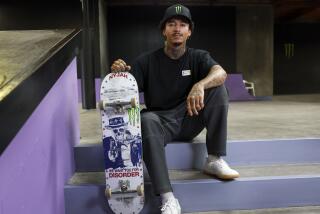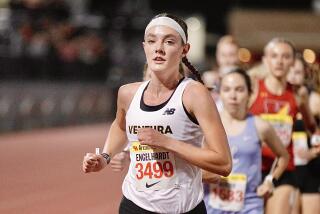Class of ’76 : ERIC HULST, Track and Cross-Country Champion : He’s Going the Distance, One Day at a Time
- Share via
Eric Hulst wants to play his guitar again. Wants to get back to his wallpapering business. Would love to see Hawaii. Would like to rock climb. Do that bike ride up Mt. Baldy. And run more miles in one outing than most of us care to drive.
But life is filled with limits, as Hulst, a Laguna Beach High track and cross-country star in the mid-1970s, certainly understands. Nearly 10 months after doctors removed 80% of a cancerous tumor from his brain--and told him he had two to three years to live--Hulst says he’s living one day at a time. But unlike some of his doctors, he remains confident about his future.
“At this point, I consider myself having as much of a chance of living--or dying--as anyone,” says Hulst, 34.
The kitchen of his mother’s Newport Beach apartment, where Hulst lives, is stocked with what Hulst believes to be his remedy: organic nuts and seeds, whole-grain cereals, fresh fruit and vegetables--Hulst consumes 25 pounds of carrots a week, usually in juice form--plus a greenish liquid called Kyo-green, a mixture of barley and wheat grass.
Add to that 5,000 milligrams of Vitamin C each day and a list of prescription drugs Hulst calls his “medicine menu,” and you have the basis of a nutrition plan prescribed for Hulst by an alternative cancer treatment center in Mexico.
Sure, Hulst says, he was skeptical when he first heard about alternative treatment, but not anymore. Before he started the treatment in August, he could barely stand or walk without a cane. Now his appetite is back, he’s walking or jogging two to four miles each day, and he feels healthy.
Besides, he says, his seizures, those small earthquakes that rumble and radiate through his body every so often, are fewer and farther between now. His doctors tell him that’s a good sign.
Hulst was walking out of a theater one night last February with his mother, Sharon, when he felt something snap inside his head while yawning. Suddenly, he couldn’t close his mouth, and he couldn’t talk. When his jaw muscles went into contractions, Hulst went to the hospital, where he was given Valium and told to get some rest. But weeks later, after he lost control of his left arm trying to change gears on his bike, Hulst was given a Magnetic Resonance Imaging test. It revealed a tumor the size of a golf ball on the right side of his brain.
Hulst underwent six hours of surgery the next day. Doctors told him they had to leave 20% of the tumor so as not to risk brain damage. Six weeks of radiation therapy followed, leaving Hulst physically exhausted.
Emotionally, though, he was high, thanks to a tremendous outpouring of support from family and friends--even strangers. Ralph Serna, his longtime rival from Loara, called him from Taiwan and Korea. Steve Scott, Hulst’s teammate at UC Irvine, came to visit. Runners and coaches from around the county--and around the country--sent him cards and letters.
Athletes he didn’t know embraced him and cried on his shoulder. He was their hero, they told him, please get well.
A Laguna Beach couple whom Hulst had never met sent him money, saying they remembered his spirit and wished him well. Several Laguna Beach restaurants put on a dinner in his honor and raised $13,000 for medical expenses. His church in Newport Beach raised $8,000.
Hulst says he couldn’t understand the response. He stopped running competitively years ago--a knee injury and a disinterest in academics ended his career after his sophomore year at UCI--so how could he be an inspiration to anyone?
He might not understand, but plenty do. Hulst personified the spirit of running and racing like few others. His workouts were legendary. There were 10-mile morning runs, from Emerald Bay to Corona del Mar and back. There were the mile repeats on the El Niguel golf course--4:20 pace on average. There was the 31 Hills run, Top of the World Drive repeats, the stadium steps while wearing a 10-pound lead vest. . . .
Corona del Mar’s Brian Hunsaker said the strain of training with Hulst was a main reason he contracted mononucleosis. Racing against Hulst gave most people a good view of the back of his head. Serna, now a designer for a running shoe company, said there was something about Hulst that no other runner had, a Zen-like coolness, a quiet confidence that made him impossible to psyche out.
But it was his power, his unsurpassed tenacity, that made him legendary. His county record in the two-mile (8:44.6) also ranks him as the sixth-fastest high school runner in U.S. history. He still holds national two-mile records for freshmen (9:04.4), sophomores (8:50.6) and juniors (8:44.9). He won a world junior cross-country championship in Wales in 1975--making the cover of Runner’s World--winning by 14 seconds.
The list goes on and on, though you’d never know it by talking to Hulst. He is, as always, humble about his accomplishments, saying he’s pleased he could make so many people happy just by doing what he did best.
And maybe soon, he says, he’ll race again. His three visits a week to a Newport Beach physical therapist have made a huge difference in his range of motion and motor skills, he says. He has regained full use of his left arm--it became partially paralyzed after his surgery--and last week, he purchased new running shoes.
This morning, Hulst planned on going on a five-mile training run with a friend. It will be his longest run since he retired more than a decade ago, and certainly the greatest exercise he has attempted since surgery. He warns us, though, not to expect a speedy pace.
“I’m just getting started, you know,” Hulst says.
We wish him luck every step of the way.
More to Read
Go beyond the scoreboard
Get the latest on L.A.'s teams in the daily Sports Report newsletter.
You may occasionally receive promotional content from the Los Angeles Times.










